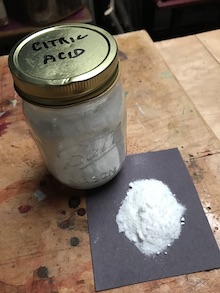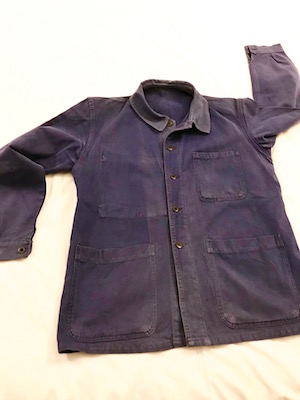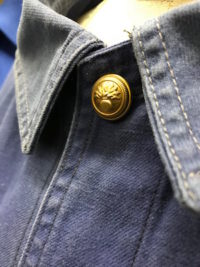What I wear in the wood shop is influenced by the activities I have planned. A simple thing like a shop jacket or chore coat can set the tone.
That just might be the next woodworking project. Or an art project. Or simply research.
Wood straight off the tree is dirty, dusty, and buggy. Lumber yard wood can be dirty, buggy, and wet, too. I aways bring my work gloves to avoid splinters, finger pinches, and to get a good grip.
Dangers on the Bench
I might kick up my own dust and shavings when sawing or planing boards. Finishing a project with shellac, oils, dyes, or paint can get messy. Even a lone drop of paint can ruin a shirt. And confirming Murphy’s Law, it seems to be a new one, always.
Chemicals in the shop are caustic and dangerous. They damage tools, clothing, mucus membranes, eyes, skin, and lungs. Their effects are usually not revealed until long after the damage has been done.
Personally, I use the gentlest methods available, when possible. My weapons of choice for finishing shop projects are water-based. When I use substances that are oil-based, deeply pigmented, or have micro particles, I use them sparingly and with care.
Funny how I’ve gotten paint or stain on almost everything I’ve worn in the shop!
Refurbishing tools comes with its own problems. Removing age old rust and dirt provides a dilemma regarding the method used to clean the tools.

Powdered citric acid is my go-to for removing rust from old tools. It’s non-toxic. I just make a soaking solution by dissolving the powder in water. I make sure to always have it on hand.
It’s all about personal safety
Painters, nurses – almost every profession – have their clothing requirements. Putting on proper work clothes is motivating and puts me in the right mindset to do my best work.
I wear clothes that are sturdy and heavy enough to protect my body. Things you don’t think can cause injury may not come to mind right away. They do teach a painful lesson, nonetheless. Think paper cut!
Do I get bumps and bruises maneuvering materials in my small space? I get them all the time.
I make sure that my toes are covered. As much as I love wearing sandals, I don’t wear them in the shop, while working. I wouldn’t like to drop any heavy or sharp object on my toes. That is an understatement. I wear shop shoes that protect my instep and my toes.
I love sundresses in summer, but I don’t wear them in the shop when I’m working. I wear long sleeved sweat shirts to protect my arms. And I always wear jeans, never shorts, to protect the rest of me!
I don’t wear rings when I work. I do wear a watch and a close-fitting bead bracelet or two as my project talisman. That’s my indulgence, but please, don’t do this in your shop!

I made a shop apron or two and try to make it a habit to wear one. Sawdust is hard to get out of your clothes!
Enter the french chore coat
When I was in Paris this summer, I went to the flea market in the 18th arrondissement, Marche aux Puces de St-Ouen.
Initially, I went to look for tools. I wasn’t having much luck. I spotted, however, a booth with work clothes, mostly cotton and denim jackets and pants.
Ah! Vintage and old shop jackets or french chore jackets. These garments are also called chore coats. These denim jackets or coats were worn over overalls by laborers, workers, and farmers since the late nineteenth century.
Since I appreciate fashion history and design, I stepped inside just to study the clothing on the racks. I was the only one in the booth for a long while, so I took my time. I tried on many jackets comparing condition and price and thinking about what I would be willing to pay.
I found NOS (new old stock) jackets in great, almost pristine condition. They were priced accordingly. There were a few definitely shop worn items with holes, paint splatters, and tears.
I knew I would have luck and get a good price somewhere between the pristine jackets and well-worn ones. Most of those jackets were in good condition with minor issues. A tiny hole here or a button missing there gave a garment character. A wear mark on the cuff or collar did not affect wearability.
Believe it or not, those condition issues are highly desired by fans of the chore jacket. Late NY fashion photographer, Bill Cunningham, found his recognizable blue chore jacket in Paris.
I tried on many jackets to find a fit and look for me. Most of them, in many styles by various manufacturers, didn’t have size tags. Some markings had been washed out long ago. The clothing sported (metric) mens sizing.
Like anything else, it matters if the manufacturer is well-respected and has been around a long time. Jackets made by Le Laboureur go for premium prices. As usual, price is not always influenced by condition alone.
I worked hard searching through that booth. I’d find something that was perfect and really what I wanted but it would be either too tight or too big.
I found a couple of jackets that I kept trying on, going back and forth between the two. Did I want cotton drill or moleskin? I compared their stitching, condition, fit and price.
Even the shade of color, bleu de travail or blue work, comes at a premium. Hydrone, a medium blue or Bugatti, a vibrant blue considered more sophisticated, were the most popular shades. The original worker’s jackets also came in black for going to church.
These shop jackets are not cheap! I already said that.
I finally made my pick, the cotton jacket and looked for the vendor. She ran another booth across the way that contained interesting smalls and ephemera.
I asked her if she could give me a better price. We did not go back and forth too much and finally settled on a good price. And I had my french chore coat!

Next step: making the shop jacket mine
Now that I had my jacket, I wanted to personalize it by switching out the buttons.
I finally found another booth that had a lot of old buttons, many still on their cards. I started looking through baskets and bins, trying to find the perfect buttons. I only needed seven.
I saw some carded metal buttons that would be perfect to change out the look of the jacket.
When I got back to the shop, I switched out the resin buttons for old brass.


The jacket looks nice and professional. It is ironic that I am careful with it. Certainly, I don’t treat it like a tatty tee-shirt. I wear it and work in it. I’m just careful. But like the owner of a new car that gets its very first dent, I’ll be sad when that first speck of paint or stain hits it!
Now I feel protected when I’m working.

Great look. I’m happy.
Bonjour!
-Shirley J
💙


2 thoughts on “● Song of the Shop Jacket”
That was really interesting, I enjoyed the trip keep up the good work.
Thank you. I appreciate the company!